Panic attacks can feel like one of the most terrifying experiences you can go through. Your heart races, your breathing quickens, and dizziness sets in — it can feel like you’re losing control or even about to pass out. One of the most common fears people have during a panic attack is that they will faint, especially when they’re in public. But can a panic attack really make you faint? Let’s take a closer look at what happens during a panic attack and why fainting is highly unlikely.
Why You Feel Like You’re Going to Faint
During a panic attack, your body’s natural “fight or flight” response kicks in, triggered by a rush of adrenaline. This response causes:
- Increased heart rate
- Rapid breathing (hyperventilation)
- Tension in your muscles
- Dizziness and lightheadedness
The dizziness often comes from hyperventilation, which lowers carbon dioxide levels in the blood. This can make you feel lightheaded or detached from your surroundings, but it doesn’t mean you will actually lose consciousness.
Fainting usually occurs when blood pressure drops suddenly, causing reduced blood flow to the brain. However, panic attacks tend to increase blood pressure due to the adrenaline surge, making fainting highly unlikely. So while it may feel like you’re on the verge of passing out, your body is actually doing the opposite — keeping you alert and ready to respond.
The Real Fear: Humiliation or Losing Control in Public
Even though fainting is unlikely, the fear of fainting or losing control in public is very real. Many people worry that if they have a panic attack in a public place, others will judge them or think something is seriously wrong. This fear of being humiliated or seen as weak can add an extra layer of anxiety to an already overwhelming experience.
In fact, this fear can lead to agoraphobia — an anxiety disorder where you start avoiding places or situations where you fear having a panic attack. People with agoraphobia might feel trapped or unsafe outside their homes, particularly in crowded places, public transport, or anywhere they can’t easily escape. This avoidance can severely limit daily activities and quality of life.
Panic Disorder and the Cycle of Fear
For some people, the fear of having a panic attack becomes so intense that it leads to panic disorder. This condition is characterized by recurring, unexpected panic attacks and ongoing worry about when the next attack might happen. This constant anxiety can create a cycle where the fear of having a panic attack actually triggers more panic attacks.
How Therapy Can Help
If panic attacks and the fear of public humiliation are taking over your life, therapy can make a huge difference. Cognitive Behavioral Therapy (CBT) is especially effective for addressing panic disorder and agoraphobia. It helps you:
- Understand your body’s response to fear
- Challenge distorted thoughts about fainting and losing control
- Develop coping strategies to manage symptoms
- Gradually face situations that trigger panic in a safe, supportive way
Learning how to manage your anxiety can help break the cycle of panic and restore your confidence. With the right support, you can move beyond the fear of panic attacks and start reclaiming your daily life.
Final Thoughts
While it may feel like fainting during a panic attack is inevitable, the truth is that your body’s adrenaline response makes it unlikely. The real challenge often lies in overcoming the fear of humiliation or being seen as out of control. Therapy can help you work through these fears, build resilience, and take back your sense of freedom and confidence.
If you’re ready to work on overcoming panic attacks and the anxiety they cause, reach out to a therapist who specializes in anxiety disorders. You don’t have to go through it alone — support is available.
Ready to begin? Start your online therapy journey today. Book your first session now.




